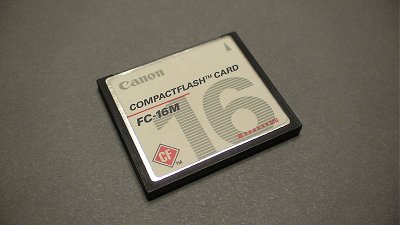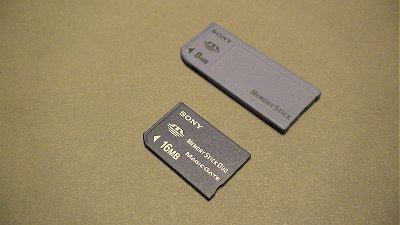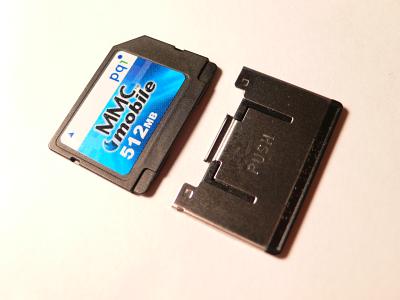Type of Memory Cards
Once upon a time, memory storage card came only in one format: CompactFlash. Soon, a new champion, named SmartMedia, came to challenge the king of the hill. The challenger couldn't dethrone the king. Vise-versa, the king couldn't banish the challenger. So there were these two competing standards. Today, there are a bunch of challengers all wanting to be king. Therefore this article will introduce them all to you.
CompactFlash (CF)
CompactFlash is the de facto standard to flash memory Storage. It is used everywhere from digital cameras to MP3 players to embedded systems. There are two variants of Compact Flash: Type 1 & Type 2. CF Type 2 cards are a little bit thicker than CF type I Cards. Currently CF Type 2 cards house devices like Microdrive and WiFi network Card. CF cards are very robust and industrially proven to be reliable.

Memory Stick
Unlike the other memory card types, the Memory Stick is a proprietary standard invented by Sony. As always, Sony has to invert and push its own standards instead of joining the rest of the industry. Memory Stick uses a serial interface to transfer data between the host device and card. It turned out that Sony's physical design is far more robust and reliable than SmartMedia design. Unfortunately, the original memory Stick design also has a 128 MB limitation.

PRO
Sony Memory Stick PRO is the new Standard to eliminate the 128 MB limitation. Currently, Memory Stick PRO is available up to 1 GB. Memory Stick PRO will not work in devices that only support the standard Memory Stick. But Memory Stick PRO devices are compatible with the original Memory Stick. Today, all 128MB, and under, cards are Memory Stick, while all larger cards are Memory Stick PRO.
Duo
Memory Stick Duo and Memory Stick Pro Duo are basically smaller versions of the Memory Stick and Memory Stick Pro. The Duo has pin-to-pin compatibility with its older and larger Memory Stick sibling. Therefore, some Duo cards are shipped with a Sony MSAC-M2 Memory Stick Duo Adapter so that you can use it with your Memory Stick devices. If you have photographic equipment that uses Memory Stick, I suggest you buy only Duo cards from now on to lengthen the longevity of your storage cards' usability.
MagicGate
MagicGate is Sony's name for digital rights management (DRM), a copy-protection technology. It encrypts the data stored on the card and enforces control over how the files on the card are copied. Few hardware devices take advantage of MagicGate today.
MultiMediaCard (MMC)
Another challenger was the MultiMediaCard. MMC is smaller but slightly thicker than the SmartMedia cards. Its interface pins are on its backside and lay similarly to Memory Stick. However, MMC were not popular with the masses. Perhaps it looks too much like SmartMedia card, or manufacturers had too much invested in CompactFlash and SmartMedia to switch over to MMC.
Reduced Size MultiMediaCard (RS-MMC)
RS-MMC is based on the same technology as regular MMC and provides the same performance. However, it is about half the size of a MMC. Through an extender adapter, RS-MMC could be used in MMC devices. The size reduction allows RS-MMC to fit in today's small and thin mobile phones.
MMC Mobile
MMC Mobile flash memory has the exact same form-factor as the RS-MMC flash memory. It could be used in a MMC slot as well through the extender adapter. But MMC Mobile provides several new features compared to its sibling, such as ultra high-speed memory access and dual voltage operation.

Secure Digital Card (SD card)
Secure Digital card is basically the second generation MultiMediaCard. They are exactly the same as MMC physically, other than the extra locking switch on the SD Card. The locking switch prevents data from being read, written, and deleted from the storage card. A SD Card device can also read and write MMC. However, SD card has a digital rights management (DRM) capability that is not available in MMC. To this date, I have not seen the digital security feature being used.

SD Card is generally limited to 2 GB in side. However, there are some obscure 4 GB versions. Most of the higher capacity cards are using the SDHC stancard (see below).
mini
Recently a new smaller SD Card has emerged on the market. It is called the miniSD Card. The card is originally intended for use in mobile phones and miniature electronics, such as MP3 players. Because most miniSD Card packages include a SD Card adapter, you can use miniSD Card in your SD Card devices. In fact, I suggest that you buy miniSD card, rather than the larger SD card, for your SD Card devices from now on. By doing so, you are guaranteed that your storage card's operational life is lengthened.
micro
The microSD Card is even smaller than the miniSD Card. The microSD Card is designed for use in cellular phones and small mobile devices. The microSD Card can accessed in a SD Card slot via an adapter.
SanDisk originally introduced the microSD Card as the TransFlash card in 2004. The TransFlash Card has just been approved by the IEEE and recently adapted by the SD Card Association. The final standard will be called the microSD by the end of 2005.
SDHC
SDHC stands for Secure Digital High-Capacity. These cards can have the same form-factor as the other SD cards, but the internal storage can handle up to 32 GB of data. Older generation SD Card readers cannot read the new SDHC Cards.
SDXC
SDXC stands for Secure Digital eXtended-Capacity. These cards can have the same form-factor as the other SD cards, but the internal storage can handle up to 2 TB of data. Older generation SD Card readers and SDHC Card readers cannot read the new SDXC Cards.
SmartMedia
SmartMedia card is the first challenger to the flash memory market. It was jointly invented by Olympus and Fuji. It became quite popular among manufacturers and consumers. It is smaller and thinner than the CF cards. It also has contact pins directly on the surface of the card. This design proved to be less reliable than the CF interface design when used over time. Bat the real reason that caused the demise to SmartMedia cards is its 128 MB limitation.

xD-Picture Card
xD-Picture Card is a contender invented and promoted by Olympus and Fuji. Once again Olympus and Fuji tried to gain market share by inventing and promoting their own format. Currently only Olympus and Fuji cameras support xD-Picture Card. Therefore, it hasn't picked up much popularity among consumers and will probably not take off as a mainstream storage card form-factor.
Related Links
- CompactFlash Association
- CompactFlash, MMC, SD Cards Roundup
- Comparison of memory cards
- Difference between mmc and sd memory
- Flash Memory Card Primer
- Hi-Speed xD-Picture Card (Type H) and Standard xD-Picture Card (Type M)
- Make a PCMCIA Slot Memory Card Carrier
- Memory Stick Developers' Site
- Memory Stick Pinout
- MultiMedia Card Pinout
- Pick a card ... any card
- Secure Digital - Wikipedia
- Secure Digital Card Pinout
- Secure Digital I/O Card Pinout
- SmartMedia Card Pinout
- TransFlash memory card
137 Users Online
|
$10000-above $5000-$9999 $2000-$4999 $1000-$1999 $500-$999 $200-$499 $100-$199 $50-$99 $25-$49 $0-$24 Gift Certificate |
|




